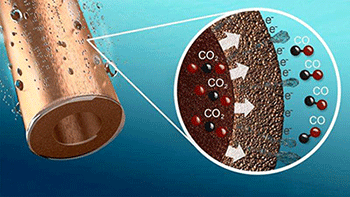 Carbon dioxide accounts for over 80 percent of all greenhouse gas emissions. For many, carbon dioxide emissions account for significant environmental issues, but for researchers like Haotian Wang of Harvard University, carbon dioxide could be the perfect raw material.
Carbon dioxide accounts for over 80 percent of all greenhouse gas emissions. For many, carbon dioxide emissions account for significant environmental issues, but for researchers like Haotian Wang of Harvard University, carbon dioxide could be the perfect raw material.
According to a new study, Wang and his team are well on the way to developing a system that uses renewable electricity to electrochemically transform carbon dioxide into carbon monoxide. The carbon monoxide could then be used in a host of industrial processes, such as plastics production, creating hydrocarbon products, or as a fuel itself.
This from Harvard University:
The energy conversion efficiency from sunlight to CO can be as high as 12.7%, more than one order of magnitude higher than natural photosynthesis.



